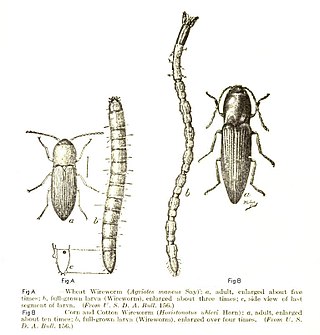
Elateridae or click beetles are a family of beetles. Other names include elaters, snapping beetles, spring beetles or skipjacks. This family was defined by William Elford Leach (1790–1836) in 1815. They are a cosmopolitan beetle family characterized by the unusual click mechanism they possess. There are a few other families of Elateroidea in which a few members have the same mechanism, but most elaterid subfamilies can click. A spine on the prosternum can be snapped into a corresponding notch on the mesosternum, producing a violent "click" that can bounce the beetle into the air. Clicking is mainly used to avoid predation, although it is also useful when the beetle is on its back and needs to right itself. There are about 9300 known species worldwide, and 965 valid species in North America.

George Charles Champion was an English entomologist specialising in the study of beetles.
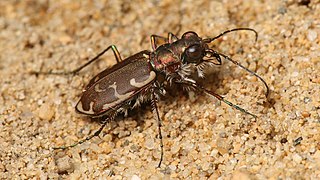
Cicindela repanda, commonly known as the bronzed tiger beetle or common shore tiger beetle, is a species of tiger beetle that is 10–13 millimetres (0.39–0.51 in) long and lives in most of North America. It has a small labrum with one tooth and a coppery, hairy pronotum. The shoulder marking usually touches the middle band. It is most often seen in spring and summer, and it lives in sand, gravel, or clay soil. It feeds on many species of insects and even some fruit. The species has a two-year life cycle. It can be found across sand dunes around the Great Lakes. The species comprises three subspecies: C. repanda repanda, C. repanda novascotiae, and C. repanda tanneri.

Larry is a British domestic tabby cat who has been Chief Mouser to the Cabinet Office at 10 Downing Street since 2011. He is cared for by Downing Street staff and is not the personal property of the prime minister of the United Kingdom. Larry has lived at 10 Downing Street during the premierships of six prime ministers: David Cameron, Theresa May, Boris Johnson, Liz Truss, Rishi Sunak and Keir Starmer.
Colasposoma aeneoviolaceum is a species of leaf beetle of the Democratic Republic of the Congo. It was first described by the Belgian entomologist Louis Jules Léon Burgeon in 1941.

Chilocorus nigritus, sometimes referred to as the Malaysian ladybird beetle, is a species of lady beetle in the family Coccinellidae. It is native to SE Asia, but has been introduced for use in biological pest control in Hawaii and many parts of the world, including Europe.
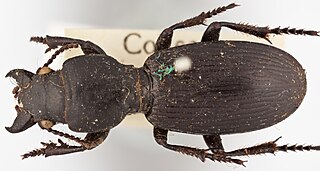
Mecodema curvidens Broun is a medium-bodied ground beetle that is geographically widespread throughout the central areas of the North Island, New Zealand, which includes the entomological regions of Auckland (AK), Waikato (WO), Coromandel (CL), Bay of Plenty (BP), Taupo (TO), Rangitikei (RI), Whanganui (WI), Hawkes Bay (HB) and Wellington (WN). Recently, the species M. occiputale Broun was synonymised under M. curvidens. Mecodema curvidens is relatively common through its range except in the southern area of the Hunua Ranges (Auckland) and Wellington regions.
Coelostoma (Holocoelostoma) stultum, is a species of water scavenger beetle widely distributed in Palearctic and Oriental realms from West Pacific towards Indian Ocean, such as China, Taiwan, Andaman Islands, Myanmar, India, Indonesia, Japan, Korea, Malaysia, Mascarene Islands, Nicobar Islands, Oman, Philippines, Saudi Arabia, South Korea, Sri Lanka, Thailand, United Arab Emirates, Oman, and Vietnam.

Cybister tripunctatus, is a species of predaceous diving beetle found in India, Andaman & Nicobar Islands, Sri Lanka, Afghanistan, Bangladesh, Myanmar, Nepal, Pakistan, Bhutan, China, Cyprus, Iran, Iraq, Japan, Kyrgyzstan, Mongolia, Russia, Syria, Tajikistan, Turkmenistan, Italy, Turkey, Uzbekistan and Europe.
Arixyleborus mediosectus, is a species of weevil found in India, Sri Lanka, Cambodia, Myanmar, Philippines, Malaysia, Indonesia: Sumatra and Vietnam.

Henosepilachna septima, is a species of lady beetle found in Vietnam, Indonesia, Malaysia, India, Sri Lanka and Pakistan.
Synona obscura, is a species of lady beetle found in India and Sri Lanka.
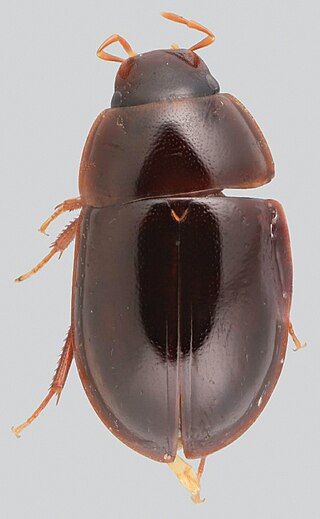
Primocerus is a Neotropical genus of water scavenger beetle in the family Hydrophilidae represented by nine described species known from the Guiana Shield Region.

Caccothryptus larryi is a species of minute marsh-loving beetle in the subfamily Limnichinae. The species was described alongside five other Caccothryptus species by Natural History Museum entomologist Keita Matsumoto in 2021, using specimens gathered in 1953 by Harry George Champion in Haldwani, India. Both of the c. larryi specimens featured genital structures distinct from Champion's initial classification of C. ripicola. The species was named for Larry, the Chief Mouser to the Cabinet Office at the British Prime Minister's residence at 10 Downing Street.
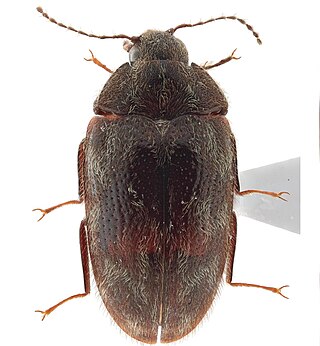
Caccothryptus arakawae is a species of minute marsh-loving beetle in the subfamily Limnichinae. The species was described alongside five other Caccothryptus species by Natural History Museum entomologist Keita Matsumoto in 2021, using specimens gathered by Martin J. D. Brendell at Kathmandu, Nepal in 1983. Six of Brendell's specimens were distinguished from its initial classification of Caccothryptus testudo due to distinct genital structures. The species was named for Hiromu Arakawa, the creator of manga series Fullmetal Alchemist.

Caccothryptus brendelli is a species of minute marsh-loving beetle in the subfamily Limnichinae. The species was described alongside five other Caccothryptus species by Natural History Museum entomologist Keita Matsumoto in 2021, using specimens gathered by Martin J. D. Brendell at Kathmandu, Nepal in 1983. One of Brendell's specimens were distinguished from Caccothryptus testudo due to distinct genital structures and labeled C. brendelli after Brendell.

Caccothryptus championi is a species of minute marsh-loving beetle in the subfamily Limnichinae. The species was described alongside five other Caccothryptus species by Natural History Museum entomologist Keita Matsumoto in 2021, using specimens gathered in 1953 by Harry George Champion in Haldwani, India alongside an earlier 1925 specimen collected nearby. Like the other Caccothryptus species described by Matsumoto, it was distinguished from its original classification of C. ripicola due to differences in the shape of its genitalia. Twenty-seven specimens from the British Natural History Museum collection were identified with C. championi, named after Champion.

Caccothryptus abboti is a species of minute marsh-loving beetle in the subfamily Limnichinae. The species was described alongside five other Caccothryptus species by Natural History Museum entomologist Keita Matsumoto in 2021, using specimens gathered in 1953 by Harry George Champion in Haldwani, India alongside an earlier 1925 specimen collected nearby. Like the other Caccothryptus species described by Matsumoto, it was distinguished from its original classification of C. testudo due to differences in the shape of its genitalia. One specimen collected by Champion was identified as the holotype for C. abboti and named for English radio presenter Nick Abbot.
Caccothryptus yunnanensis is a species of minute marsh-loving beetle in the subfamily Limnichinae. The species was described in 2018 by enomologist Hiroyuki Yoshitomi. Although part of the species group C. testudo, it is related to the C. compactus species C. chayuensis) and C. thai due to serrae due to their shared small notches along the median lobe. It is distinguished from these due to its straight parameres, which are curved in C. chayuensis and C. thai. C. yunnanensis specimens were collected by Yu-Tang Wang across the Chinese provinces of Guizhou and Yunnan, the latter of which gave the species its name. It is almost entirely black in coloration, except for dark and light brown in its antennae and legs. It has an average length of around 5 mm. The holotype of C. yunnanensis is a male collected in Xima, Yunnan in 2014.
Caccothryptus is a genus of minute marsh-loving beetle in the subfamily Limnichinae. The genus was first described by entomologist David Sharp in 1902, with C. compactus as the type species.














